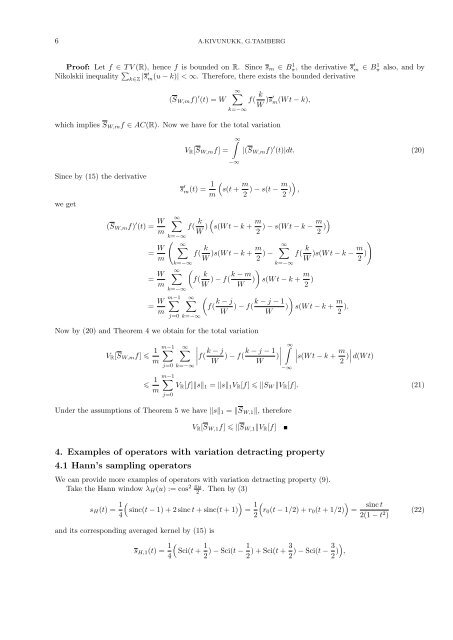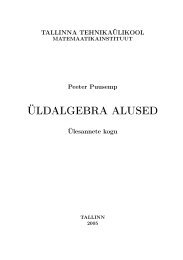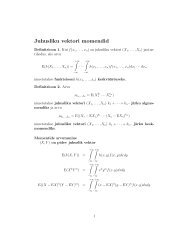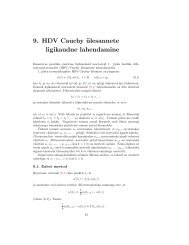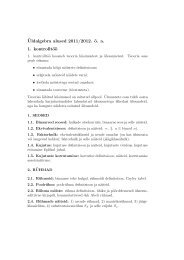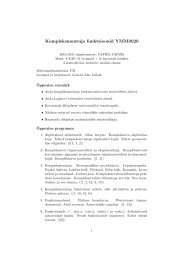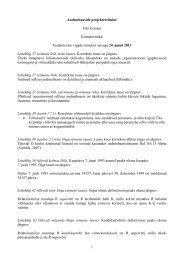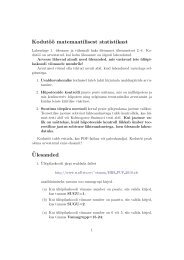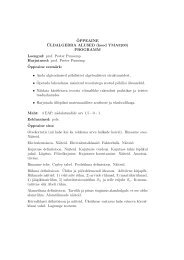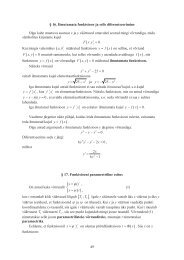SHANNON SAMPLING SERIES WITH AVERAGED KERNELS1 1 ...
SHANNON SAMPLING SERIES WITH AVERAGED KERNELS1 1 ...
SHANNON SAMPLING SERIES WITH AVERAGED KERNELS1 1 ...
Create successful ePaper yourself
Turn your PDF publications into a flip-book with our unique Google optimized e-Paper software.
6 A.KIVUNUKK, G.TAMBERG<br />
Proof: Let f ∈ T V (R), hence f is bounded on R. Since sm ∈ B 1 π, the derivative s ′ m ∈ B 1 π also, and by<br />
Nikolskii inequality <br />
k∈Z |s′ m(u − k)| < ∞. Therefore, there exists the bounded derivative<br />
(SW,mf) ′ (t) = W<br />
∞<br />
k=−∞<br />
f( k<br />
W )s′ m(W t − k),<br />
which implies SW,mf ∈ AC(R). Now we have for the total variation<br />
Since by (15) the derivative<br />
we get<br />
(SW,mf) ′ (t) = W<br />
m<br />
∞<br />
k=−∞<br />
k=−∞<br />
VR[SW,mf] =<br />
s ′ m(t) = 1<br />
<br />
m<br />
f( k<br />
W )<br />
<br />
∞<br />
−∞<br />
s(t + m<br />
2<br />
s(W t − k + m<br />
2<br />
|(SW,mf) ′ (t)|dt. (20)<br />
m<br />
) − s(t −<br />
2 )<br />
<br />
,<br />
m<br />
) − s(W t − k −<br />
2 )<br />
<br />
= W<br />
<br />
∞<br />
f(<br />
m<br />
k=−∞<br />
k<br />
∞ m<br />
)s(W t − k + ) −<br />
W 2<br />
k=−∞<br />
= W<br />
∞<br />
<br />
f(<br />
m<br />
k − m<br />
) − f(k<br />
W W )<br />
<br />
s(W t − k + m<br />
2 )<br />
= W<br />
m−1 <br />
m<br />
∞<br />
j=0 k=−∞<br />
<br />
f(<br />
k − j<br />
W<br />
Now by (20) and Theorem 4 we obtain for the total variation<br />
VR[SW,mf] 1<br />
m−1 <br />
m<br />
j=0 k=−∞<br />
∞<br />
<br />
<br />
<br />
− j − j − 1<br />
f(k ) − f(k<br />
W W<br />
)<br />
<br />
<br />
<br />
<br />
f( k<br />
m<br />
)s(W t − k −<br />
W 2 )<br />
<br />
− j − 1<br />
) − f(k<br />
W<br />
)<br />
<br />
s(W t − k + m<br />
2 ).<br />
∞<br />
−∞<br />
<br />
<br />
s(W t − k + m<br />
2 )<br />
<br />
<br />
d(W t)<br />
1<br />
m−1 <br />
VR[f]s1 = s1VR[f] SW VR[f]. (21)<br />
m<br />
j=0<br />
Under the assumptions of Theorem 5 we have s1 = SW,1, therefore<br />
VR[SW,1f] SW,1VR[f]<br />
4. Examples of operators with variation detracting property<br />
4.1 Hann’s sampling operators<br />
We can provide more examples of operators with variation detracting property (9).<br />
2 πu<br />
Take the Hann window λH(u) := cos . Then by (3)<br />
sH(t) = 1<br />
<br />
<br />
sinc(t − 1) + 2 sinc t + sinc(t + 1)<br />
4<br />
and its corresponding averaged kernel by (15) is<br />
sH,1(t) = 1<br />
<br />
4<br />
2<br />
Sci(t + 1<br />
2<br />
) − Sci(t − 1<br />
2<br />
= 1<br />
<br />
<br />
r0(t − 1/2) + r0(t + 1/2) =<br />
2<br />
sinc t<br />
3<br />
3<br />
) + Sci(t + ) − Sci(t −<br />
2 2 )<br />
<br />
,<br />
2(1 − t 2 )<br />
(22)


